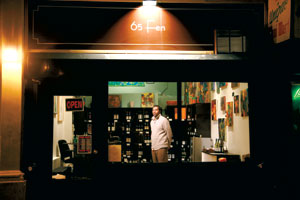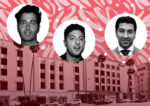Trending
Pushing PLG over the edge
<i>Prospect Lefferts Gardens still hasn't fully taken off, but residents are trying to change that</i>

Michael Campbell at 65 Fen, a wineshop he opened in December in Prospect Lefferts Gardens.Prospect Lefferts Gardens, the Brooklyn neighborhood that hugs the east side of Prospect Park (effectively mirroring Park Slope on the west), has been touted as an up-and-coming neighborhood for more than a few years now. But somehow it’s never quite caught on in the way that some other neighborhoods have.
Though the area is full of tree-lined streets dotted with well-priced limestone townhouses that sit back on their own lawns, there are only a few restaurants, cafés, boutiques and other stores to speak of.
“Amenities like restaurants and stuff [are] definitely sparse compared to other neighborhoods,” said Victoria Hagman, owner of Realty Collective and Manzione Real Estate. “But I think people are beginning to realize that it’s an untapped market.”
PLG residents, however, don’t seem interested in waiting for others to appreciate their “untapped market.” Instead, they are taking matters into their own hands, determined to help transform their neighborhood.
The last few years have seen the opening of K-Dog & Dunebuggy, a café and coffee shop on Lincoln Road at Flatbush; Enduro, a Mexican restaurant; and Sushi Tatso, on Flatbush. More recently an Indian restaurant, King of Tandoor, opened at 600 Flatbush Avenue, and residents have been trying to woo the Farmer’s Diner, a Vermont-based restaurant that was reportedly looking for space in the area.
However, not all of the new restaurants have made it. Late last year, Fly Fish was one of several restaurants run by restaurateur Jim Mamary that shuttered in Brooklyn.
Still, residents of the PLG neighborhood seem to have ramped up their efforts recently to create a groundswell of support for new additions to the area. In some cases, they are jumping into the fray themselves.
Take the December opening of the wineshop 65 Fen on Fenimore Street, which was started by 25-year PLG resident Michael Campbell. “A couple of years ago, I walked into this local wine shop like I normally do, and the treatment was so bad. I was like, ‘I can do better than this,'” he said.
Now, in the 400-square-foot-space, he offers wine tastings on Saturdays and displays local artists’ work. Campbell declined to disclose his rent.
Meanwhile, Karen Oh, who moved to PLG with her husband in 2005, last summer started a food co-op and began recruiting neighbors to join. When it opens (Oh is aiming for 2012 or 2013), she hopes the co-op will serve the entire community.
Also relatively new is PLGArts, a local artists’ organization that coordinates concerts, theater and outdoor crafts fairs. There is also a charter school on the way. Both were initiated by residents who already live in PLG, and are chronicled on the neighborhood blog hawthornestreet.com.
Real estate experts expect all of the activity to enhance home values and make the neighborhood more attractive to other buyers.
“A chronic issue for people who come to live here was schools. They love the neighborhood, but then [it was], ‘Where am I going to send my kid to school?'” said Barbara Rogers, an independent real estate broker and franchisee of William B. May who lives and works in Prospect Lefferts Gardens. “There were people in the neighborhood who started the idea of a charter school and then pushed for it.”
“There is a very active, very aware community,” Rogers added. “It’s not just younger and newer residents; it’s people who have been here for years and years. … For a while, it was less vivacious than it is now, but it’s gotten a second wind of people coming into the neighborhood, building on what was already there.”
And the people are coming.
“There seem to be a lot of young artists and families that realize they can get more for their money out there,” said Hagman.
In fact, in January, PLG’s real estate landscape took a big leap forward.
A circa-1901 townhouse sold for $932,000 outside the neighborhood’s historic district, where the $900,000 mark had never before been attained on a two-story house. The home was purchased six years ago for $280,000, but was significantly renovated.
“[It was] a record for a house that’s not in the Manor,” said Rogers. The Manor — which sits within the neighborhood’s historic district and is zoned for single-family homes — runs from the north side of Fenimore Street to the south side of Lincoln Road and from the east side of Flatbush Avenue to the west side of Rogers Avenue, and contains the most expensive housing stock in the area. That the townhouse achieved the price it did outside the Manor, and the historic district as a whole, bodes well for the area’s property values.
“[The sale] will significantly impact the neighborhood, especially those blocks outside the historic district,” said Brown Harris Stevens’ Bette Cunningham, the agent who represented the seller in the transaction.
Hagman estimates that one- to three-family houses sell for between $300 and $350 a square foot, and co-ops between $250 and $300 a foot, a significant discount over the stock on the other side of the park or even in nearby Prospect Heights.
Because available land is sparse, new developments are rare, but there are a few. For example, 59 Hawthorne, a 20-unit new construction condo building, will open for sales this month, with one-bedrooms starting at $230,000 and two-bedroom duplexes for $500,000.
“We are targeting first-time home buyers, as well as those who want to stay in the neighborhood and can’t afford a limestone,” said Highlyann Krasnow, a partner at the Developers Group, which is marketing the building.
Construction has also started up again on the hotly contested 185 Ocean Avenue, an eight-story residential building set to rise in a lot where an older home once stood.
But new developments aren’t what’s drawing buyers — it’s the townhouses, brokers say.
“We wanted a house and to be close to the park, but we were priced out of Prospect Heights, and we knew we wouldn’t be able to afford the west side of the park,” said Oh, who with her husband bought a two-story limestone with a basement.
“We didn’t know very much about this neighborhood, but we found this house that needed a lot of fixing up and we walked around and decided it’s a really great neighborhood, it’s really pretty but it’s not manufactured, it’s not super-spruced-up. It feels like a real Brooklyn.”
As Rogers put it: “People are waking up to the value in this neighborhood.”




